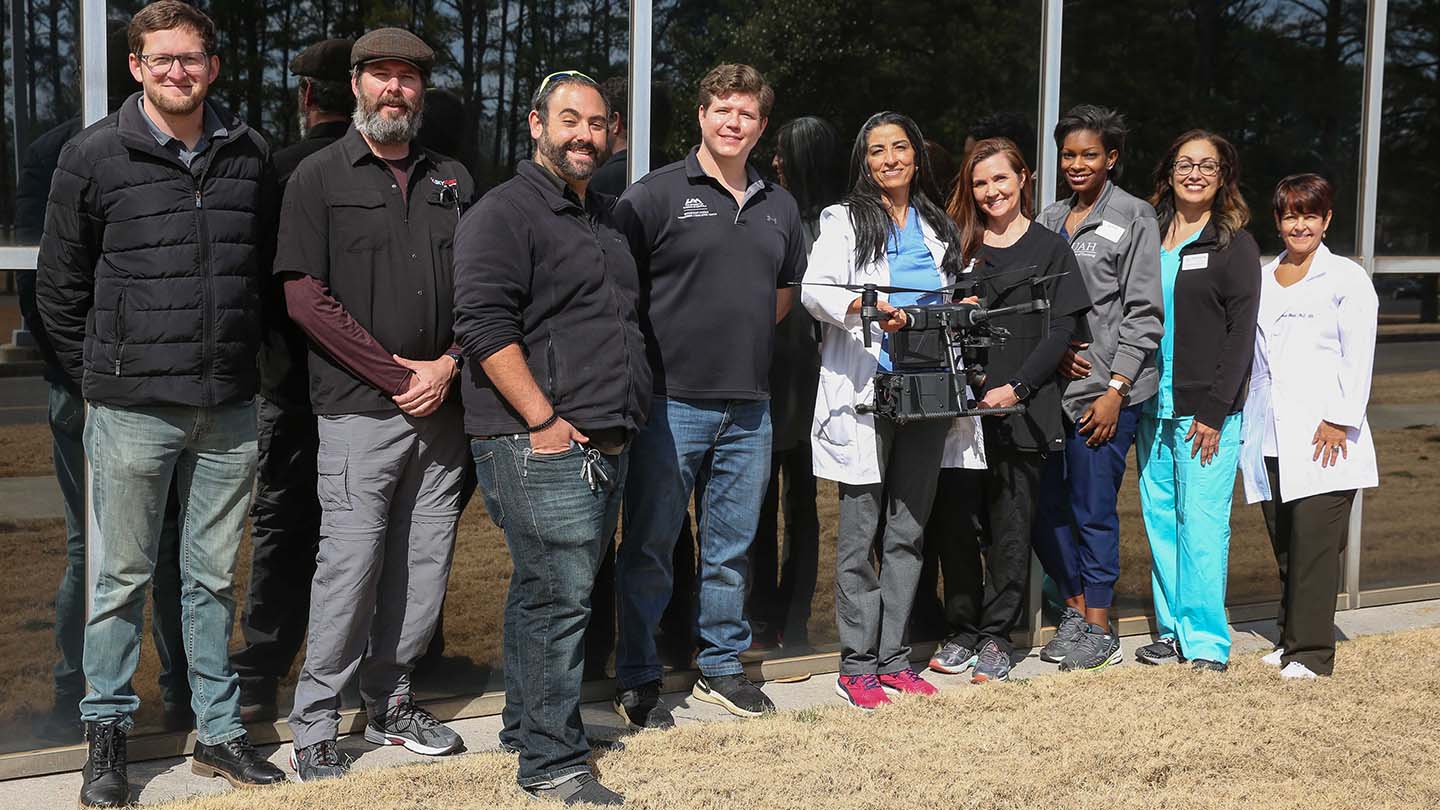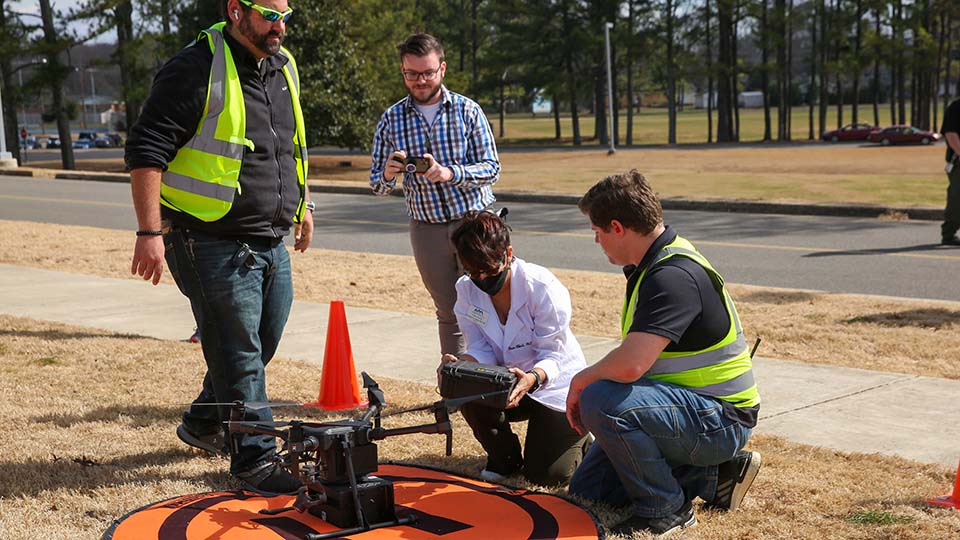
Participating in the drone demonstration were, from left, Jake Meslo, Dan Parker, Matt Sloane, Casey Calamaio, Azita Amiri, Kim Budisalich, Jarmel Poole, Darlene Showalter and Pam O'Neal.
Michael Mercier / UAH
Getting vital healthcare services and supplies can be a challenge for rural patients because of the long distances involved and because smaller communities lack doctors, nurses and clinics.
So, the College of Nursing at The University of Alabama in Huntsville (UAH), a part of the University of Alabama System, and the UAH Rotorcraft Systems Engineering and Simulation Center (RSESC) Unmanned Aircraft Systems (UAS) Program began to wonder if drones might be a better way.
The effort is led by Dr. Azita Amiri, an associate professor of nursing, and Casey Calamaio, an RSESC research engineer.
For six years, Dr. Amiri has chaired the 40-year-old Nursing and Aerospace Committee, perhaps the only such collegiate committee in the nation.
“We have been working on several projects in utilizing drones in telehealth,” Dr. Amiri says.
Drone delivery could be ideal, as it keeps patients at home and avoids any constraints in rural infrastructure on the way. UAS provide a unique platform for short-range delivery of time-sensitive payloads. Using drones for delivery of healthcare services is well documented in humanitarian relief efforts or during significant natural disaster events in rural locations across the globe.
The UAH collaborators recently tested drone delivery technologies and approaches for nursing education on campus, with an eye to refining the system for use in the rural United States.
Led by Dr. Darlene Showalter, the simulation involves a pregnant woman at risk for preterm labor who arrives at a rural hospital. Reflecting real life, the hospital has encountered supply-chain issues associated with the global COVID-19 pandemic and has limited capabilities and staff.
Nurses perform a focused preterm labor assessment and receive a prescription for fetal fibronectin (fFN) and betamethasone, but neither is available in the rural agency. Using a drone, an urban clinic sends the medicine and a fetal fibronectin (fFN) testing kit. fFN is a protein produced during pregnancy that’s used to predict risk for preterm delivery and betamethasone is vital for maturing fetal lungs in the event of preterm birth.

UAH and Skyfire Consulting personnel test drone delivery of medical supplies on the UAH campus.
Michael Mercier | UAH
Upon receipt, the nursing staff at the rural hospital immediately unloads the supplies, performs the fFN test and sends the specimen back to the urban clinic via drone.
“This simulation was designed to promote creative and viable decision-making by nurses,” Dr. Showalter says. “We are equipping our students to collaborate and think through real-life issues that serve as obstacles to healthcare equity. I am grateful for the faculty of the maternity course, who quickly embraced this innovative learning opportunity for their students.”
“This simulation model can also be used as a pilot for medical services delivery in our hospital systems in Huntsville,” Dr. Amiri says. “Our team is now working on a simulation where we have a case of an overdose in a rural area, and a drone is used to deliver the life-saving medication naloxone to reverse the effects of opioids.”
Both the obstetric and overdose simulations are designed to bring nursing students to the table in the planning and implementation of solutions to make an impact in the health of the community.
Helping Dr. Amiri and Calamaio lead the simulation were nursing professor Dr. Pamela O’Neal, clinical associate professors Dr. Showalter and Dr. Kim Budisalich, and nursing instructor Jarmel Poole. A local industry partner with expertise in public safety UAS, Skyfire Consulting, provided an aircraft and medical payload to the team for the demonstration.
“This demonstration provided a simple scenario to test unmanned aerial delivery solutions in a campus environment,” Calamaio says. “We also had a chance to identify areas with radio frequency interference in urban environments, considerations for UAS traffic management, and to discuss effective ways to introduce UAS in the local medical community.”
A custom payload bay made of Kydex, a thermoplastic acrylic-polyvinyl chloride material, and standard ruggedized cases that are widely used by emergency services were tested on the UAS.
“This prototype payload for medical supply delivery paves the way for more rigorous testing to see how transportation on a UAS affect different medicine containers, samples, and in particular, liquids with specific temperature or vibration sensitivity,” Calamaio says. “The demonstration builds off the UAS Research Program’s expertise in disaster response and emergency services research with the Federal Aviation Administration (FAA).”
There are 57.2 million people living in rural areas, based on the 2020 U.S. Census. That’s 17.3% of the population.
“Limitations in healthcare services in disadvantaged communities lead to delay in diagnosis, as well as inconvenient patient and physician experiences,” Dr. Amiri says. “They also lead to reduced medication adherence, poor diagnostics for treatment and universal healthcare issues, such as antibiotic resistance.”
In Alabama, which covers 50,744 square miles with a 2020 estimated population of 5,024,279, there are 1,146,765 people living in rural areas, or 23% of the population, according to the U.S. Department of Agriculture’s Economic Research Service.
“In addition, citizens in rural areas are more likely to experience health disparities,” Dr. Amiri says. “People have to travel 30-40 miles to reach a clinic or a health center in many rural areas.”
About 2 years ago, her committee connected with the RSESC and “we noticed the strong capacity and capabilities of the Unmanned Aircraft Systems Programs at UAH,” she says.
“We’re trying to connect nursing, aerospace, and Unmanned Aircraft Systems and use it in the systems in healthcare to improve nursing care and patient outcome.”
Current FAA regulations and rules limit U.S. drone package delivery functions. Walmart has tested drone delivery of COVID-19 testing kits, but it provided service only to patients who lived within a one-mile radius of the designated supercenters to adhere to FAA regulations that the drone must be visible while flying.
“Significant coordination with the FAA to safely implement a rural UAS delivery system is required,” Calamaio says. “Challenges in assured operational safety and regulatory compliance need addressing before UAS are used as delivery mechanisms on the scale to tilt the medical supply chain in a significant way.”